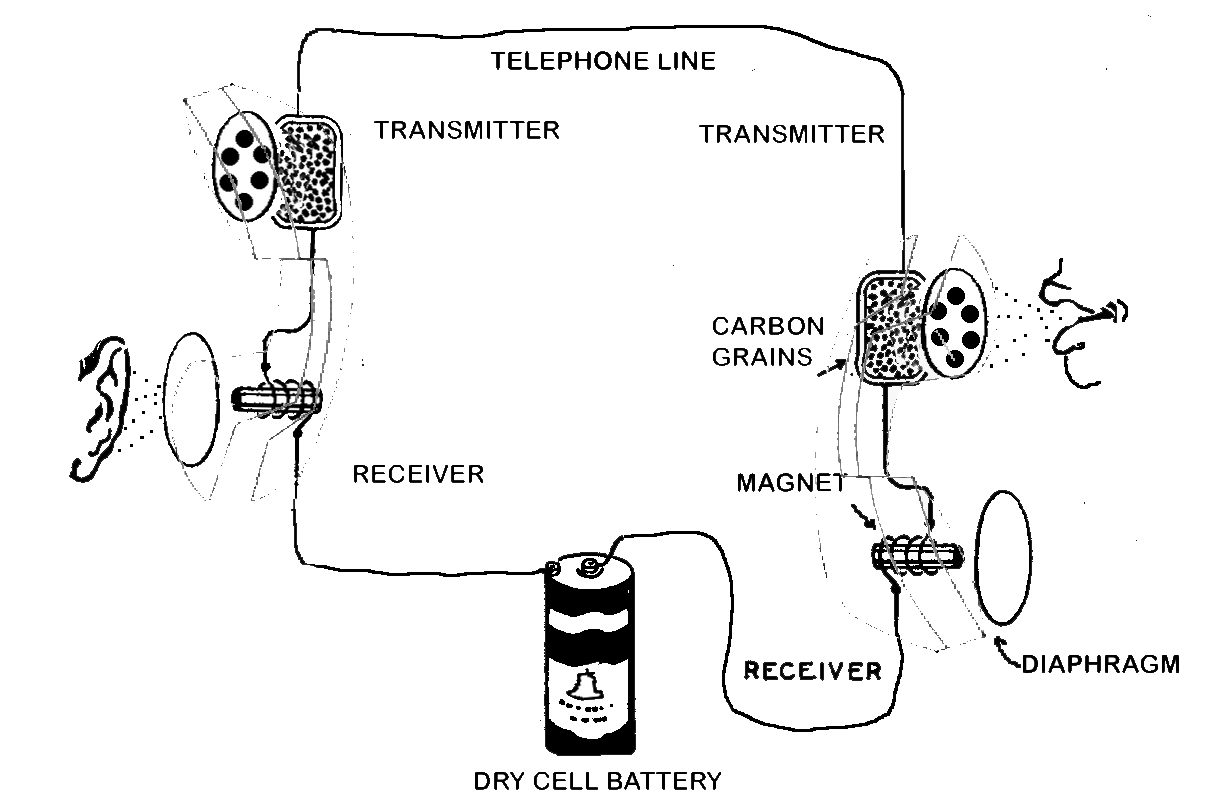|
How
the Telephone Works
When a person speaks into a telephone,
the sound waves created by his voice enter the mouthpiece. An
electric current carries the sound to the telephone of the person
he is talking to. A telephone has two main parts: (1) the transmitter
and (2) the receiver.
The Transmitter of a telephone serves as a sensitive "electric
ear." It lies behind the mouthpiece of the phone. Like
the human ear, the transmitter has an 14 eardrum." The
eardrum of the telephone is a thin, round metal disk called
a diaphragm. When a person talks into the telephone, the sound
waves strike the diaphragm and make it vibrate. The diaphragm
vibrates at various speeds, depending on the variations in air
pressure caused by the varying tones of the speaker's voice.
Behind the diaphragm lies a small cup filled with tiny grains
of carbon. The diaphragm presses against these carbon grains.
Low voltage electric current travels through the grains. This
current comes from batteries
at the telephone company. The pressure on the carbon grains
varies as sound waves make the diaphragm vibrate. A loud sound
causes the sound waves to push hard on the diaphragm. In turn,
the diaphragm presses the grains tightly together. This action
makes it easier for the electric current to travel through,
and a large amount of electricity flows through the grains.
When the sound is soft, the sound waves push lightly on the
diaphragm. In turn, the diaphragm puts only a light pressure
on the carbon grains. The grains are pressed together loosely.
This makes it harder for the electric current to pass through
them, and less current flows through the grains.
Thus, the pattern of the sound waves determines the pressure
on the diaphragm. This pressure, in turn, regulates the pressure
on the carbon grains. The crowded or loose grains cause the
electric current to become stronger or weaker. The current copies
the pattern of the sound waves and travels over a telephone
wire to the receiver of another telephone. For more modern phones
that have a telephone
answering service, the sound wave is captured on a recording
device which allows for the operator of the phone to playback
at a later time.
The Receiver serves as an "electric mouth." Like a
human voice, it has "vocal cords." The vocal cords
of the receiver are a diaphragm. Two magnets located at the
edge of the diaphragm cause it to vibrate. One of the magnets
is a permanent magnet that constantly holds the diaphragm close
to it. The other magnet is an electromagnet. It consists of
a piece of iron with a coil of wire wound around it. When an
electric current passes through the coil, the iron core becomes
magnetized. The diaphragm is pulled toward the iron core and
away from the permanent magnet. The pull of the electromagnet
varies between strong and weak, depending on the variations
in the current. Thus, the electromagnet controls the vibrations
of the diaphragm in the receiver.
The electric current passing through the electromagnet becomes
stronger or weaker according to the loud or soft sounds. This
action causes the diaphragm to vibrate according to the speaker's
speech pattern. As the diaphragm moves in and out, it pulls
and pushes the air in front of it. The pressure on the air sets
up sound
waves that are the same as the ones sent into the transmitter.
The sound waves strike the ear of the listener and he hears
the words of the speaker.


|